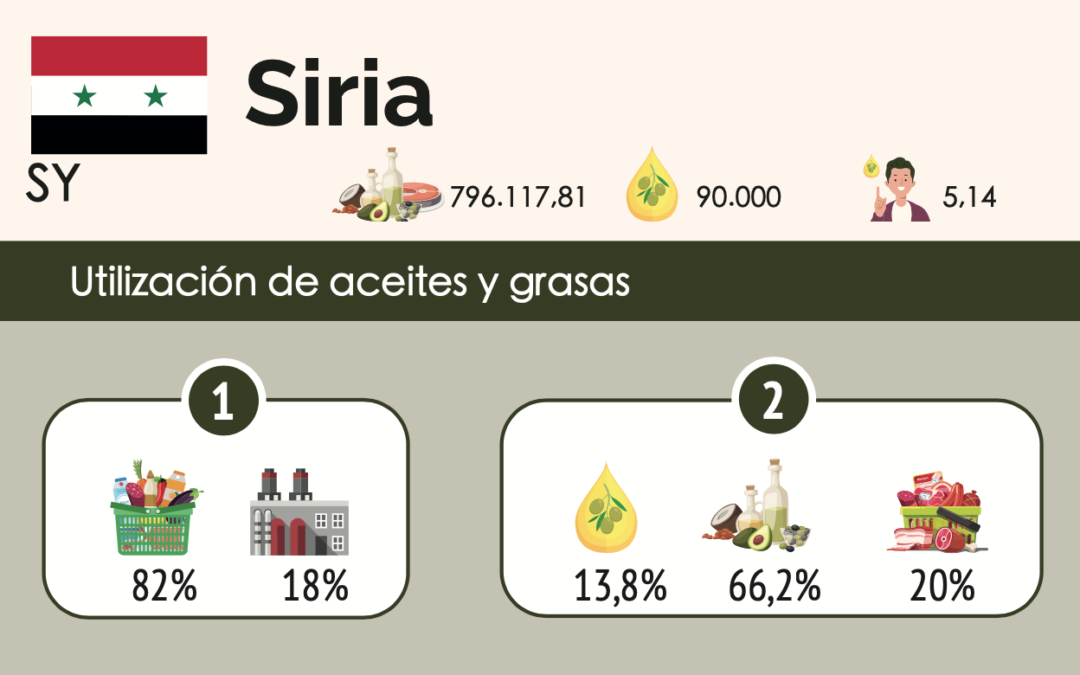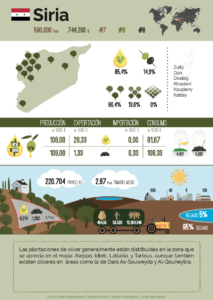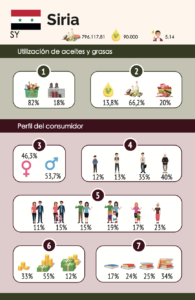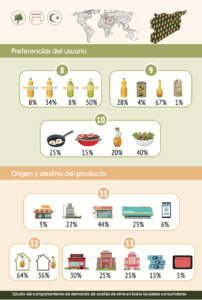Syria is a sovereign country in the Near East, on the eastern Mediterranean coast and has 17.5 million inhabitants. It ranks seventh in cultivated area and eighth in olive oil production. Olive plantations are generally distributed in the area of Aleppo, Idleb, Lattakia, and Tartous, although there are also olive groves in areas such as Dara As-Souweyda and Al-Qouneytira. Its agriculture, favored since 1978 by the construction of the Tabka dam, which makes it possible to irrigate large areas, is mainly dedicated to the cultivation of cereals, cotton, olives trees and vegetables.
Traditional crops predominate in a majority way (86.5%), and in a minority amount intensive crops (13.6%). All of these crops are rainfed (95%).
The percentage of olive grove production for olive oil production is 85.4% and 14.6% for table olive production. The predominant olive grove varieties in this country are: Zaity, dan, doebly, khodeiri, koudeiry and kaissy.
It produces 108,000 tons of olive oil, of which 26,330 tons are exported. The 40% corresponds to an oil of a high quality (virgin or extra virgin), and 60% to a lower quality, such as lampante. In addition, 109,000 tons of table olives are produced, of which 1,330 tons are exported.
With respect to the number of plots, there are a total of 220,704 in this country, of which the average size per plot is 2.67 hectares. In addition, the productivity per hectare is 0.214 tons of olive oil and 1.262 tons of table olives.
It has 550 oil mills, 40 olive oil mills, 5 refineries and 120 oil mills. The turnover generated by the olive oil sector in this country is 454.55 million euros, in which a total of 12,204,348 people work in the olive sector and related industries.
With respect to consumption in this country, 5.14 liters of olive oil are consumed per capita per year and 5.932 kg per person per year of table olives.
Of the total of animal and vegetable fats consumed, 13.8% corresponds to the consumption of olive oil.
The gender that consumes the most olive oil is male with 53.7%, while the female gender represents 46.3%. In regards to the percentage of olive oil consumption in this country with respect to age, as the age of the people increases, the percentage of consumption is higher. Thus, people over 65 years of age consume 40%, followed by people between 50 and 65 years of age with 35%. People between 34 and 49 years of age make up 13% and finally people under 34 years of age account for 12%.
Regarding the percentage of olive oil consumption according to the family structure, consumption is higher in single people or widows (23%), followed by middle-aged families with children (19%). Consumption is lower in young families without children (11%).
According to income level, people with an average income are those who consume a fairly significant percentage with respect to the rest (55%). In addition, those people who have university studies consume more olive oil than those who do not have studies.
Regarding the different categories of olive oils consumed by these people. 50% consume extra virgin olive oil, followed by olive oil (24%) and lastly olive pomace oil (8%) and virgin olive oil (8%).
The percentage of oil consumption according to the type of container, in the first place predominates the glass (67%), followed by the PET container (28%). The container where consumption is lowest is the can (4%).
The main use of olive oil in this country is as a raw product, for example for seasoning salads (40%). This is followed by fried foods (25%). Olive oil is least used for grilling (15%).
The most common place to buy olive oil is the supermarket (44%), followed by the hypermarket (25%). Olive oil purchases are lowest in traditional stores (3%).
Olive oil is consumed at home (64%) and outside the home (36%). Outside the home, the establishments where olive oil is found are bars and restaurants (30%), hotels (25%) or the canning industry (15%).




